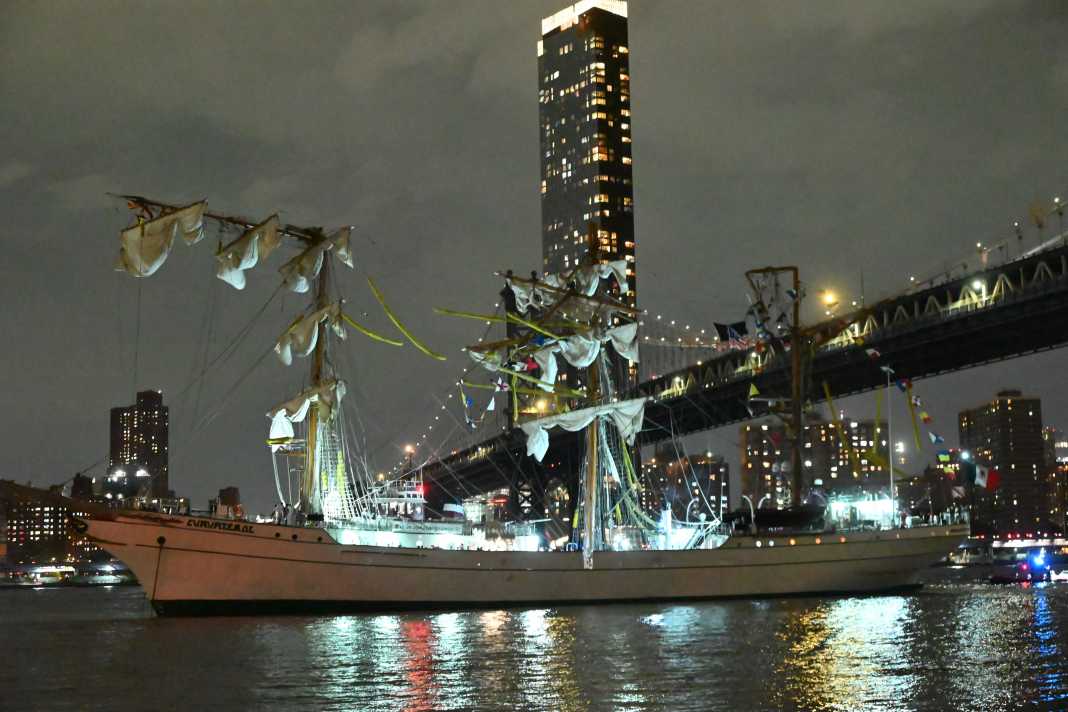





On Saturday evening at around 8.20pm, a dramatic accident occurred in New York when the Mexican sail training ship "Cuauhtémoc" collided with the famous Brooklyn Bridge. The 90-metre-long three-masted ship had just cast off from South Street Seaport and was on its way to Iceland with 277 people on board when it crashed backwards into the bridge for reasons that are still unclear. The ship's masts collided with the underside of the bridge. The Mexican Ministry of the Navy reported two fatalities and 22 other injuries, 19 of whom had to be treated in hospital. Three people suffered serious injuries.
The incident shocked hundreds of spectators who had gathered at Pier 17 to admire the festively illuminated ship. At the time of the accident, there was an incoming tide with a current of around two to three knots and a ten-knot wind from the south-west - both factors that pushed the ship towards the Brooklyn Bridge. When the ship hit the bridge, numerous cadets were in the rigging. This is common for sail training ships when they set sail and is known as "dressing ship". The crew members were roped up with safety harnesses, which presumably prevented an even higher number of casualties.
Dramatic accident
The "Cuauhtémoc" drifted backwards with the current towards the Brooklyn Bridge, unable to manoeuvre. The masts of the sailing ship, which were up to 48 metres high, snapped off like matchsticks in the collision. Parts of the masts fell down. Only tugboats and pilot boats managed to secure the damaged "Cuauhtémoc" and pull it to Pier 35. The Brooklyn Bridge was closed to traffic as a precaution, but was reopened after an inspection.
According to initial findings by the National Transportation Safety Board, the probable cause of the accident was engine failure. Apparently, the 1250 hp engine of the sail training ship failed due to a loss of power. A commission of US and Mexican experts is now investigating the exact cause. The ship's electronic data is currently being analysed in order to obtain further clues as to the cause.
Mexican President Claudia Sheinbaum expressed her condolences to the families of the two crew members who died in the accident. She instructed the Minister of the Navy to keep the public informed of the latest developments. Investigating the accident is a top priority in order to prevent similar incidents in the future and close any potential safety gaps.
The training sailing ship "Cuauhtémoc"
The "Cuauhtémoc" is the Mexican counterpart to the German naval training ship "Gorch Fock" and was modelled on the latter. Built in Spain in 1982, the ship is used to train officers and cadets in the Mexican navy. With a regular crew of 165 sailors, it trains up to 90 cadets. The barque regularly undertakes long training voyages and takes part in international maritime events as an "ambassador of the seas".
At the time of the accident, 277 people were on board the "Cuauhtémoc". The ship was on a long voyage that had started in Acapulco on 4 April and included visits to 22 ports in 15 countries. New York was just one stop on this 254-day voyage, which also included stops in the Caribbean, Europe and Germany.
The "Cuauhtémoc" was a popular guest at international sailing events and had already been confirmed for Sail 2025 in Bremerhaven. It is now extremely uncertain whether the ship will be able to take part in the event following this serious accident. The Sail organisers hope that the "Cuauhtémoc" will soon be sailing the world's oceans again and can be welcomed back to Bremerhaven at one of the next maritime festivals.
Data "Cuauhtémoc":
Technical data
- Type: Three-masted barque
- Year of construction: 1982
- Length: 90 metres
- Width: 12 metres
- Mast height: up to 48 metres
- Sailing area: 2,400 square metres
- Drive: 1250 hp engine
Crew:
- Regular crew: 165 seamen
- Training capacity: up to 90 cadets
- Persons on board at the time of the accident: 277

